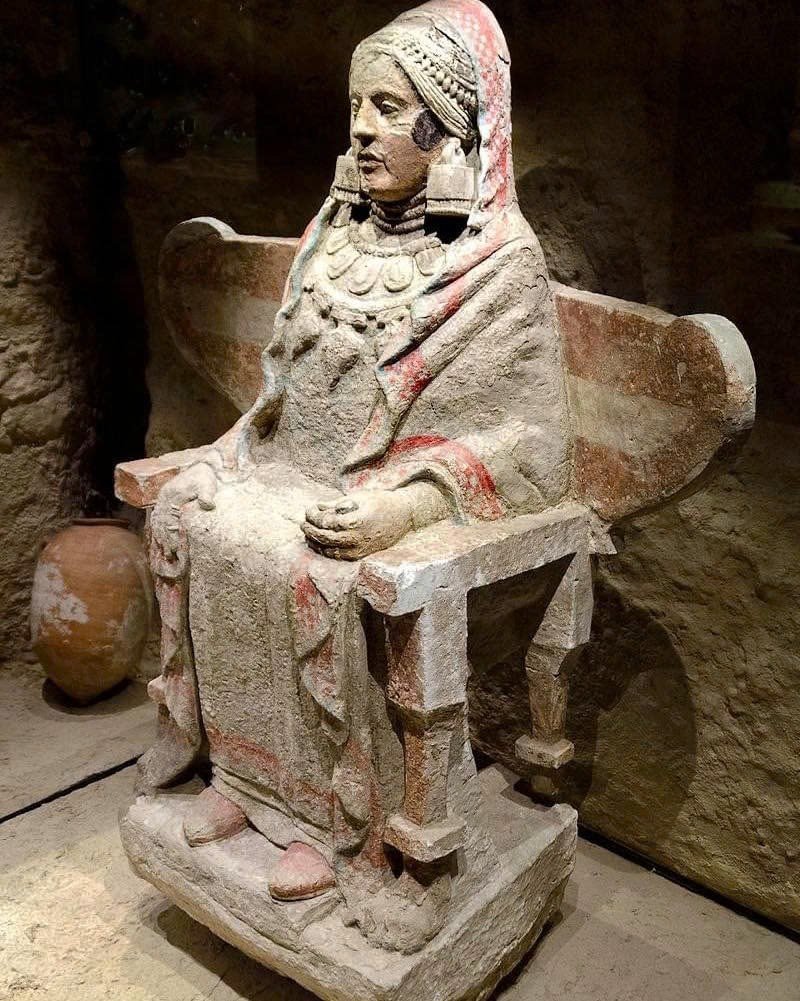In the arid, windswept plains near Granada, Spain, an astonishing discovery was made in 1971—one that would forever alter our perception of ancient Iberian civilization and its cultural complexities. Amid the burial grounds of the Baza necropolis, archaeologists unearthed a remarkable artifact now known as the Lady of Baza. This intricately carved statue, dating back to the 4th century BC, stands as a profound testament to the artistic brilliance and ceremonial sophistication of the Bastetani, an ancient Iberian people. Unlike many artifacts that simply survive the passage of time, the Lady of Baza speaks through her form and craftsmanship, offering valuable insights into a world long vanished yet still resonant with meaning today.

The Lady of Baza is not merely a statue—it is an embodiment of status, symbolism, and sacred function. Carved from limestone and carefully adorned with pigments that have miraculously survived the centuries, this seated female figure exudes an air of regality. Her posture is deliberate, with hands resting calmly on her knees, and her facial expression conveys serenity and authority. The figure’s attire is detailed and elaborate, featuring a lavish headdress and large, circular earrings that reflect not only her social standing but also the artistic traditions prevalent among Iberian elites. These features draw immediate comparisons to other notable Iberian sculptures, such as the Lady of Elche, yet the Lady of Baza possesses her own unique aura, distinguished by subtle details that set her apart.
What elevates this artifact beyond its visual appeal is the presence of color—specifically, traces of Egyptian blue and vermilion pigments that still cling to its surface. The use of Egyptian blue, a pigment first developed in ancient Egypt and known for its vibrant hue and durability, points to possible trade or cultural exchange between the Iberians and Mediterranean civilizations. This detail underscores the Bastetani’s participation in broader cultural networks, challenging the notion that Iberian societies were isolated or lacking in external influence. Instead, it suggests that these ancient peoples were engaged in a dynamic world of exchange, both material and ideological, that shaped their art and rituals.
However, the Lady of Baza’s significance goes far beyond aesthetics or trade. Archaeologists have long speculated about the statue’s function in funerary contexts. A strategically placed cavity at the statue’s back indicates that it may have served as a funerary urn, intended to hold the cremated remains of an individual of high status. If this theory is correct, the Lady of Baza was more than a symbol of power—she was a guardian of the dead, an essential part of the spiritual journey from life to the afterlife. This belief aligns with the broader spiritual practices of ancient Iberian communities, where burial objects were not mere ornaments but were considered vital companions for the soul’s voyage beyond death.
The symbolic elements embedded in the statue’s design further highlight this sacred function. Detailed knots sculpted into her garments are believed to carry protective significance, possibly representing spiritual safeguards for the deceased. These motifs suggest that the Bastetani imbued their art with layers of meaning, where every element—be it a knot, an accessory, or a pigment—held religious or protective power. Such intricacies point to a complex belief system in which life, death, and the divine were deeply intertwined.
In recent years, modern conservation techniques have allowed experts to study the Lady of Baza with greater precision than ever before. High-resolution imaging and pigment analysis have revealed previously unseen details, such as the fine lines of her facial features and the intricate patterns on her clothing. These advances have not only preserved the statue for future generations but have also deepened our understanding of Iberian artistry and social customs. Through such efforts, scholars can now reconstruct aspects of daily life, religious practices, and societal structure that were once obscured by time.
Today, the Lady of Baza resides in the National Archaeological Museum of Madrid, where she continues to inspire awe and scholarly inquiry. She draws visitors from around the world, all eager to catch a glimpse of this ancient marvel and the world it represents. Her presence in the museum is more than a showcase of ancient craftsmanship—it is a reminder of the richness of Iberian heritage and the enduring power of art to transcend time. The Lady of Baza, in her silent yet commanding form, bridges the distant past and the present, allowing us to connect with a civilization that once flourished in the heart of the Iberian Peninsula.
For those who study her, the Lady of Baza is not merely an artifact; she is a storyteller. Her form speaks of a people who valued art, ritual, and the spiritual realm. Her pigments tell of cultural connections that spanned seas. Her potential role in funerary rites illustrates a deep respect for the afterlife and the mysteries beyond. Every detail, from her regal posture to the pigments that adorn her surface, serves as a window into the lives and beliefs of the ancient Bastetani.
Ultimately, the Lady of Baza stands as a symbol of the profound depth and complexity of ancient Iberian society. She challenges us to rethink assumptions about prehistoric Europe and to recognize the sophisticated cultures that once thrived there. Her discovery continues to shape our understanding of the ancient world, offering a powerful reminder that even in death, the ancients sought beauty, meaning, and connection with the divine. Through her enduring presence, the Lady of Baza continues to illuminate the shadows of history, guiding us toward a deeper appreciation of the past’s enduring legacy.





